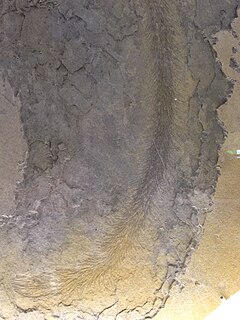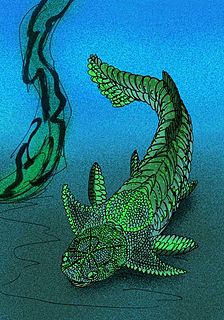Related Research Articles

Conodonts are an extinct group of agnathan (jawless) vertebrates resembling eels, classified in the class Conodonta. For many years, they were known only from their tooth-like oral elements found in isolation and now called conodont elements. Knowledge about soft tissues remains limited. They existed in the world's oceans for over 300 million years, from the Cambrian to the beginning of the Jurassic. Conodont elements are widely used as index fossils, fossils used to define and identify geological periods. The animals are also called Conodontophora to avoid ambiguity.

Baragwanathia is a genus of extinct lycopsid plants of Late Silurian to Early Devonian age, fossils of which have been found in Australia, Canada, China and Czechia. The name derives from William Baragwanath who discovered the first specimens of the type species, Baragwanathia longifolia, at Thomson River.
The Famennian is the latter of two faunal stages in the Late Devonian Epoch. The most recent estimate for its duration estimates that it lasted from around 371.1 million years ago to 359.3 million years ago. An earlier 2012 estimate, still used by the International Commission on Stratigraphy, estimated that it lasted from 372.2 million years ago to 358.9 million years ago. It was preceded by the Frasnian stage and followed by the Tournaisian stage.
The Eifelian is the first of two faunal stages in the Middle Devonian Epoch. It lasted from 393.3 ± 1.2 million years ago to 387.7 ± 0.8 million years ago. It was preceded by the Emsian Stage and followed by the Givetian Stage.

The Emsian is one of three faunal stages in the Early Devonian Epoch. It lasted from 407.6 ± 2.6 million years ago to 393.3 ± 1.2 million years ago. It was preceded by the Pragian Stage and followed by the Eifelian Stage. It is named after the Ems river in Germany. The GSSP is located in the Zinzil'ban Gorge in the Kitab State Geological Reserve of Uzbekistan, 35 centimetres (14 in) above the contact with the Madmon Formation.
The Pragian is one of three faunal stages in the Early Devonian Epoch. It lasted from 410.8 ± 2.8 million years ago to 407.6 ± 2.8 million years ago. It was preceded by the Lochkovian Stage and followed by the Emsian Stage. The most important Lagerstätte of the Pragian is Rhynie chert in Scotland. It is named after the city of Prague. The GSSP is located within the Prague Formation at Velká Chuchle, Prague.

Leclercqia is a genus of early ligulate lycopsids (clubmosses), known as fossils from the Middle Devonian of Australia, North America, Germany, and Belgium. It has been placed in the Protolepidodendrales.
Wurmiella is an extinct conodont genus.
Ozarkodina is an extinct genus of conodonts in the family Spathognathodontidae.
Palmatolepis is an extinct conodont genus in the family Palmatolepidae. It was the most abundant genus of conodonts of the Late Devonian, disappearing during the Devonian/Carboniferous crisis.
Icriodus is an extinct conodont genus in the family Gnathodontidae.
Alternognathus is an extinct conodont genus in the family Elictognathidae. An extensive study on its population dynamics and lifespan has recently been published.
Pseudopolygnathus is an extinct genus of conodonts in the family Polygnathidae.
Conodonts are an extinct class of animals whose feeding apparatuses called teeth or elements are common microfossils found in strata dating from the Stage 10 of the Furongian, the fourth and final series of the Cambrian, to the Rhaetian stage of the Late Triassic. These elements can be used alternatively to or in correlation with other types of fossils in the subfield of the stratigraphy named biostratigraphy.
Siphonodella is an extinct genus of conodonts.
Cryptotaxidae is an extinct family of conodonts in the order Ozarkodinida. It includes the extinct genus Cryptotaxis.
Cryptotaxis is an extinct genus of conodonts in the family Cryptotaxidae from the Famennian.
The Arauz Formation is an Emsian fossiliferous stratigraphic unit in Spain. It is a member of the Abadia Group. It is situated in the Province of Palencia, North Spain. It is in the north of Natural Park of Fuentes Carrionas and Fuente Cobre-Montaña Palentina where the Rio Arauz lies. It is from the Devonian of Spain.

Wufengshania is an extinct genus of bothriolepidid placoderm from the Emsian epoch of China. The type species, Wufengshania magniforaminiswas named by Zhaohui Pan et al., 2018.

Actinolepis is an extinct genus of actinolepid placoderm from the Early Devonian. Four species are known: A. magna from Estonia, A. spinosa from Latvia, the type species A. tuberculata from New Zealand and A. zaikai from Belarus.
References
- ↑ The phylomorphogenesis of some Early Devonian platform conodonts. IA Bardashev, K Weddige and W Ziegler, Senckenbergiana lethaea, December 2002, volume 82, issue 2, pages 375-451, doi:10.1007/BF03042946
- ↑ Zhor Sarah Aboussalam; Ralph Thomas Becker; Pierre Bultynck (2015). "Emsian (Lower Devonian) conodont stratigraphy and correlation of the Anti-Atlas (Southern Morocco)". Bulletin of Geosciences 90 (4): 893–980. doi:10.3140/bull.geosci.1534.